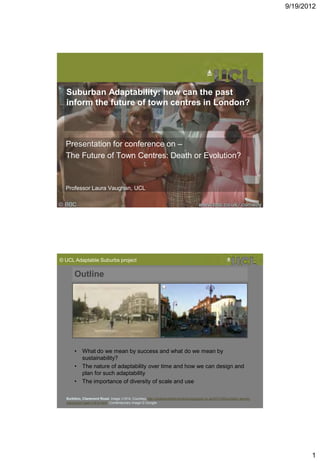Kingston future town_centres_vaughan_final
- 1. 9/19/2012
Suburban Adaptability: how can the past
inform the future of town centres in London?
Presentation for conference on –
The Future of Town Centres: Death or Evolution?
Professor Laura Vaughan, UCL
© UCL Adaptable Suburbs project
Outline
• What do we mean by success and what do we mean by
sustainability?
• The nature of adaptability over time and how we can design and
plan for such adaptability
• The importance of diversity of scale and use
Surbiton, Claremont Road. Image c1914. Courtesy http://postcardsthenandnow.blogspot.co.uk/2011/06/surbiton-surrey-
claremont-road-c1914.html. Contemporary image © Google.
1
- 2. 9/19/2012
© UCL Adaptable Suburbs project
PART ONE: TOWN CENTRE ANALYSIS
© UCL Adaptable Suburbs project
Cities are very complex systems, but they grow from a simple idea: they are
large dense aggregates of buildings linked by space. The space takes the form
of a linear network, which we call a town plan or street network.
2
- 3. 9/19/2012
© UCL Adaptable Suburbs project
• Transforming the grid to a network
© UCL Adaptable Suburbs project
Spatial Integration
HIGH
LOW
It is nearly thirty years since space syntax suggested that the street network
itself might help shape how cities worked. The fundamental purpose of cities
is to manage the relationship between people and activities within them.
3
- 4. 9/19/2012
© UCL Adaptable Suburbs project
Spatial Integration
HIGH
LOW
Holloway Road
Stoke Newington Road
Oxford Street
King’s Road
Street network model of ‘to movement’ for all London
© UCL Adaptable Suburbs project
Kingston Town Centre today
Surbiton Town Centre today
c.1820
4
- 7. 9/19/2012
© UCL Adaptable Suburbs project
PART TWO: TOWN CENTRE DIVERSITY
© UCL Adaptable Suburbs project
Understanding
London as a
network of
emergent
linked
centres, rather
than a planned
hierarchy
Kingston
Abercrombie’s plan
of London, 1944
7
- 8. 9/19/2012
© UCL Adaptable Suburbs project
113 outer London town centres ordered by commercial floorspace
Long tail of activity 900000
Croydon
(2008 data)
800000
700000
600000
500000
Flr_Space_Sqm
Approx. top 15 centres 400000
Watford
account for 50% of 300000
Uxbridge
commercial floorspace;
200000
100000
approx. 100 account for 0
the other 50% -100000
Observations
Smaller centres
contribute to sustainable
113 outer London town centres ordered by commercial floorspace (excluding Croydon, Kingston, Watford, Bromley and Ealing)
300000
Romford
urban life by supporting 250000
socio-economic and
Uxbridge
200000
cultural diversity across
Flr_Space_Sqm
150000
a wide range of activities 100000
Brent
Cross
and nurturing them at Surbiton Chipping
the local scale. Essential
50000 Barnet South
Norwood
links in the chain 0
-50000
Observations
© UCL Adaptable Suburbs project
Adaptability inherent in diversity of network over time
"Third Space" (cafes, takeaways, pubs etc.*
“Third Place”
120%
Offices & Commerce (e.g.
Offices and Commerce
solicitors, hairdressers, photographers
Industry (workshops, storage, builders‟ merch. etc.
Industry
100%
Community Services
Community (Education, Health, Religious, Leisure)
Retail (shops, shop+production, banks etc
Retail
80%
120%
60%
100%
80%
40%
60%
40%
20% 20%
0%
1869 1915 1956 2012
0%
1876 1915 1956 2012
n= 190 n= 165 n= 196 n= 240 * Oldenberg (1999) The Great Good Place. The
importance of informal public gathering places.
8
- 9. 9/19/2012
© UCL Adaptable Suburbs project
LAND-USE AND
CHOICE
Small-scale spatial model
reveals long-tail of
activity, longevity of non-
residential presence in the
area
Choice radius 400
© UCL Adaptable Suburbs project
LAND-USE AND
CHOICE
Distribution of uses varies
across location and scale of
potential journey.
Choice radius 800
9
- 10. 9/19/2012
© UCL Adaptable Suburbs project
LAND-USE AND
CHOICE
A given street or area may
be central at a local scale
but relatively segregated at
a larger scale.
Choice radius 1600
© UCL Adaptable Suburbs project
PART THREE: TOWN CENTRE
DESIGN
10
- 11. 9/19/2012
© UCL Adaptable Suburbs project
c.1915
Built Form change and adaptation
c.1875
© UCL Adaptable Suburbs project
Suburban adaptability - sustainability
From Cinema to Bingo Hall to Pub Backyard workshops in high street interland.
The Coronation Hall, Surbiton (1911) © projectkevp. Allows for diversity of users and activities
• Future of centres is same as past: not to rely on retail alone but to
encourage greater mixing within the block or even unit
• Smaller centres have the potential to provide a more
targeted, genuinely sustainable growth, because of their scale and
urban form: enabling local/non-local transactions alongside each
other
• Adaptability of the built environment relates to flexibility of use
classes and ability of network to carry different movement scales
• Consider „affordable businesses‟ as much as „affordable housing‟
11
- 12. 9/19/2012
© UCL Adaptable Suburbs project
Mixed use taken to its extreme conclusion
© UCL Adaptable Suburbs project
The boutique café: example of new form of use diversity?
12
- 13. 9/19/2012
© UCL Adaptable Suburbs project
The „hidden gem‟: taking advantage of the internet to increase physical footfall
© UCL Adaptable Suburbs project
Adaptable Suburbs Project
www.ucl.ac.uk/adaptablesuburbs
@AdaptableSuburb
Victor Buchli
Ruthie Carlisle
Ashley Dhanani
Claire Ellul
Sam Griffiths
Muki Haklay
David Jeevendrampillai
Patrick Rickles
Laura Vaughan
13

